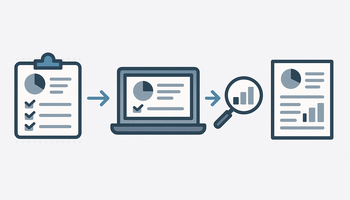
The Survey Research Process: Steps to Successfully Propose and Execute an Online Survey Project
To propose and execute a valid and reliable online survey, it takes considerable planning and sometimes a financial investment. This post outlines the major steps and considerations from defining your research purpose to completing your final report.
Purpose of Research
Determine whether survey research is the right approach to answer your questions. Is your goal to describe a population, test hypotheses, or both? Clarifying your intent shapes the entire design.
Choosing the Type of Research Design
- Cross-Sectional: One-time data collection.
- Longitudinal: Data collected at multiple points in time.
- Trend: Same population, different samples over time.
- Panel: Same population and same sample over time (note: risk of attrition).
- Cohort: Subsets within panels, like age or income groups, followed over time.
- Parallel Study Design: Same survey used across different groups or organizations, possibly repeated.
Types of Samples
Probability sampling ensures that every member of the population has a known chance of selection. Key types include:
- Random Sampling: Every individual has an equal chance of selection.
- Systematic Sampling: Selection based on a fixed interval after a random start.
- Stratified Sampling: Population divided into subgroups (e.g., gender, income), and samples drawn from each.
- Cluster Sampling: Random selection of groups or areas when full lists aren’t feasible.
- PPS Sampling: Probability proportional to size—useful for sampling areas of varying population density.
- Radius Sampling: Selection based on a geographic radius from a central point.
Pretest of Survey Instrument
Before launch, test your survey with a similar group (excluded from the main study) to identify errors or confusion. Repeat testing until no flaws remain.
Delivery of Online Survey
Send email invitations with a survey link, followed by multiple reminders to encourage participation.
Data Collection
Track completed surveys and follow up with non-respondents. For confidential surveys, participant identity is known but not disclosed. Anonymous surveys tend to yield lower response rates due to limited follow-up.
Data Cleaning
Review responses to ensure accuracy and consistency before analysis.
Data Analysis
Begin with descriptive statistics (means, frequencies), followed by inferential analysis such as cross tabulations, correlation, regression, or ANOVA to test hypotheses and identify patterns.
Research Report
Summarize methodology, results, and conclusions in a comprehensive document. Include visualizations, executive summary, and discussion of findings, especially if hypotheses were tested.
Looking Ahead
Future posts will explore each stage in detail to help you run better online surveys.

